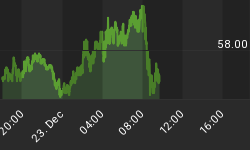Whether real or perceived, inflationary pressures are a headwind for equities.
Data out this week shows year over year changes in both CPI and PPI at five decade lows. Inflation? What inflation?
On the other hand, price trends in gold, crude oil, and Treasury yields have been strong and persistent, and in general, this is a headwind for equities. I first pointed this out in the May 12, 2009 commentary, and since that time, the S&P500 has risen as high as 6% above the closing price on that day. Today, the S&P500 is only 1.5% above the time of the initial warning.
Figure 1 is a weekly chart of the S&P500 and the indicator in the lower panel is a composite indicator that assesses the strength of the trends in crude oil, gold, and 10 year Treasury yields. When the indicator is above the upper line (i.e., inflationary pressure line) that means that these trends are strong and inflationary pressures (real or perceived) are rising. This is now the 5th week in a row that inflation pressures, as measured by this composite indicator, remain high.
Figure 1. Inflation Pressures v. S&P500/ weekly
If equities continue to rise while the trends in crude oil, gold and 10 year Treasury yields rise, then we would expect a "this time is different" scenario. In other words, prices would continue to rise on the major equity indices despite these inflationary pressures, and traders and investors would say, "Oh, this time must be different as those things don't matter." On the S&P500, a weekly close over the highs of this week (i.e., the negative divergence bar) would suggest that the "this time is different" scenario is unfolding.















